Reward System Impact: A Study of Morrison's Employee Performance
VerifiedAdded on 2023/06/04
|14
|3884
|361
Report
AI Summary
This report investigates the impact of reward systems on employee performance within the retail industry, using Morrison as a case study. The introduction outlines the research aims, objectives, and questions, focusing on the concept of reward systems, their influence on employee performance, the challenges Morrison faces in managing these systems, and strategies for improvement. The literature review delves into the concept of reward systems, identifying their positive impacts on employee productivity and motivation, while also highlighting challenges such as misalignment with organizational strategy and employee needs. The research methodology includes the research philosophy, approach, strategy, method, time horizon, data collection, and analysis, along with limitations. The conclusion summarizes the findings and implications of the study, offering insights into how reward systems can be optimized to enhance employee performance, engagement, and retention within Morrison and similar retail organizations. The report emphasizes the importance of linking rewards to desired behaviors, involving employees in program development, and ensuring rewards are perceived as achievable and valuable.
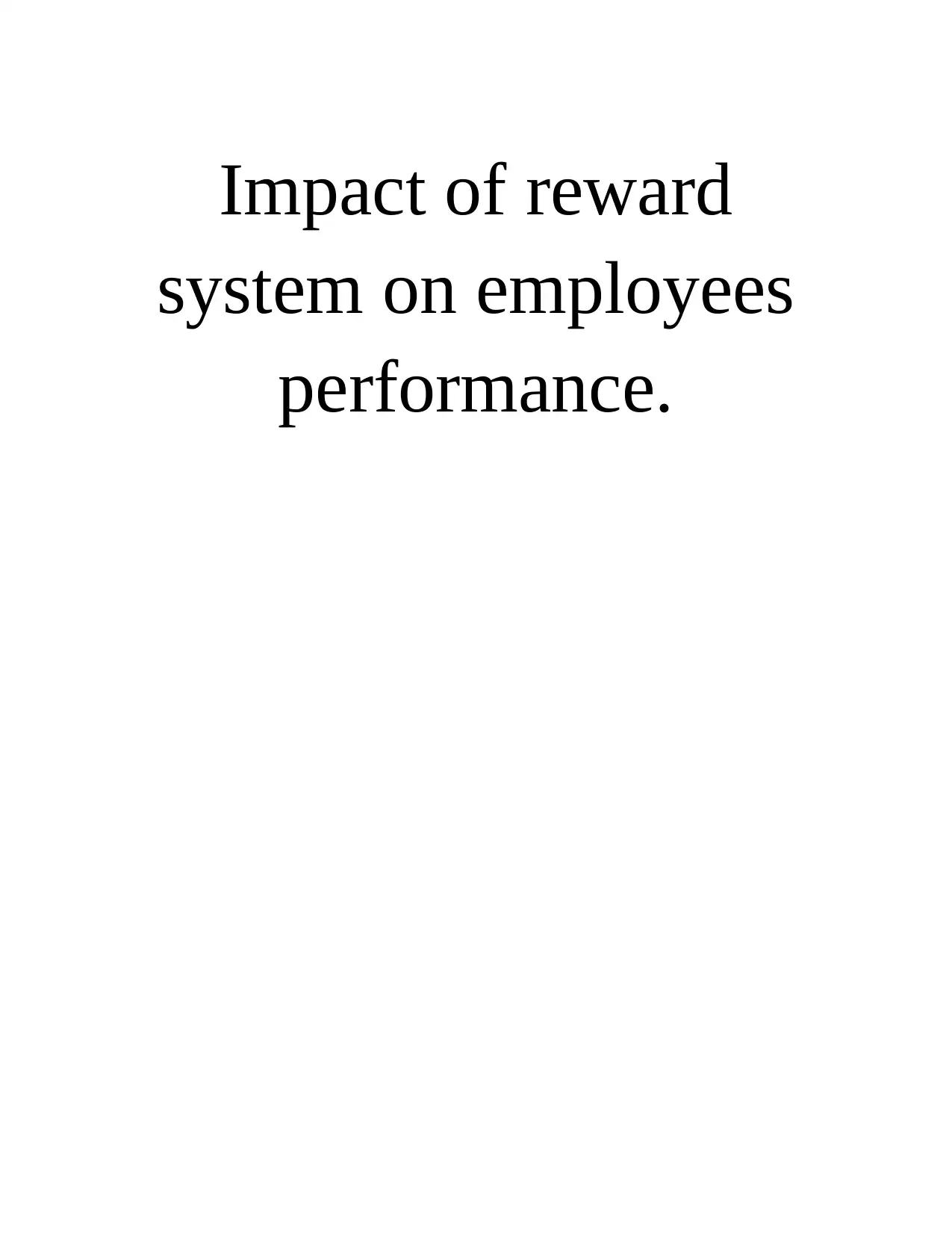
Impact of reward
system on employees
performance.
system on employees
performance.
Paraphrase This Document
Need a fresh take? Get an instant paraphrase of this document with our AI Paraphraser
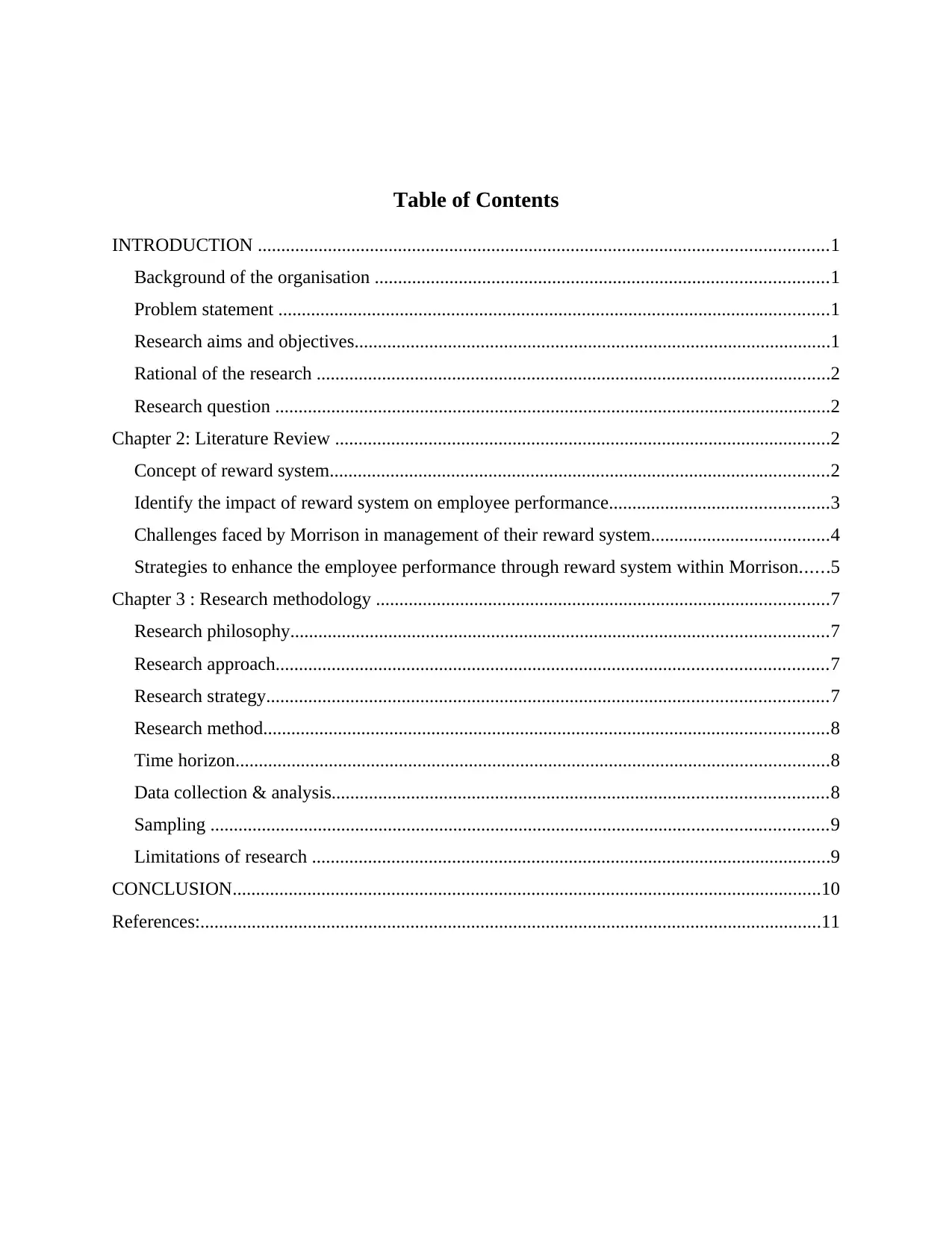
Table of Contents
INTRODUCTION ..........................................................................................................................1
Background of the organisation .................................................................................................1
Problem statement ......................................................................................................................1
Research aims and objectives......................................................................................................1
Rational of the research ..............................................................................................................2
Research question .......................................................................................................................2
Chapter 2: Literature Review ..........................................................................................................2
Concept of reward system...........................................................................................................2
Identify the impact of reward system on employee performance...............................................3
Challenges faced by Morrison in management of their reward system......................................4
Strategies to enhance the employee performance through reward system within Morrison......5
Chapter 3 : Research methodology .................................................................................................7
Research philosophy...................................................................................................................7
Research approach......................................................................................................................7
Research strategy........................................................................................................................7
Research method.........................................................................................................................8
Time horizon...............................................................................................................................8
Data collection & analysis..........................................................................................................8
Sampling ....................................................................................................................................9
Limitations of research ...............................................................................................................9
CONCLUSION..............................................................................................................................10
References:.....................................................................................................................................11
INTRODUCTION ..........................................................................................................................1
Background of the organisation .................................................................................................1
Problem statement ......................................................................................................................1
Research aims and objectives......................................................................................................1
Rational of the research ..............................................................................................................2
Research question .......................................................................................................................2
Chapter 2: Literature Review ..........................................................................................................2
Concept of reward system...........................................................................................................2
Identify the impact of reward system on employee performance...............................................3
Challenges faced by Morrison in management of their reward system......................................4
Strategies to enhance the employee performance through reward system within Morrison......5
Chapter 3 : Research methodology .................................................................................................7
Research philosophy...................................................................................................................7
Research approach......................................................................................................................7
Research strategy........................................................................................................................7
Research method.........................................................................................................................8
Time horizon...............................................................................................................................8
Data collection & analysis..........................................................................................................8
Sampling ....................................................................................................................................9
Limitations of research ...............................................................................................................9
CONCLUSION..............................................................................................................................10
References:.....................................................................................................................................11
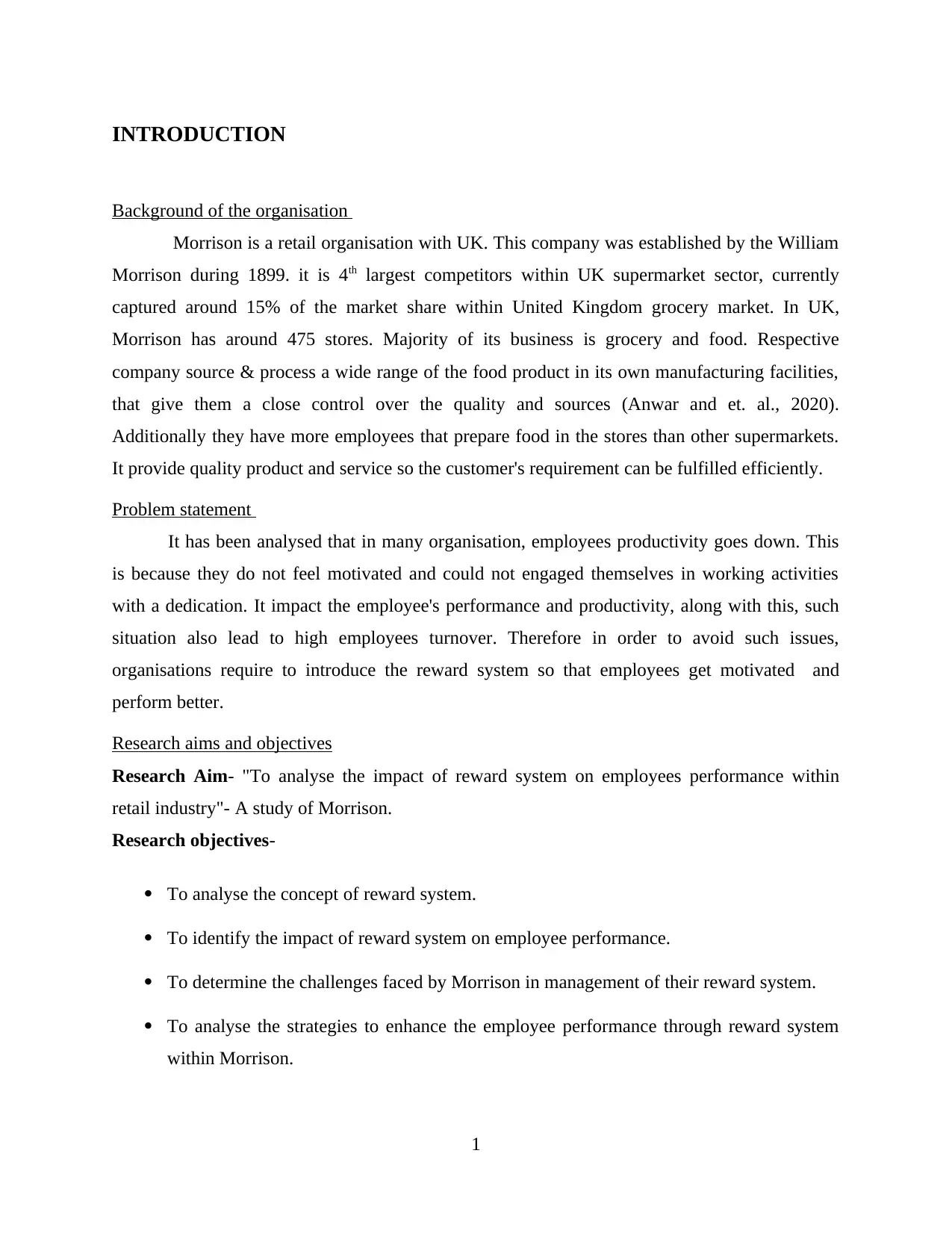
INTRODUCTION
Background of the organisation
Morrison is a retail organisation with UK. This company was established by the William
Morrison during 1899. it is 4th largest competitors within UK supermarket sector, currently
captured around 15% of the market share within United Kingdom grocery market. In UK,
Morrison has around 475 stores. Majority of its business is grocery and food. Respective
company source & process a wide range of the food product in its own manufacturing facilities,
that give them a close control over the quality and sources (Anwar and et. al., 2020).
Additionally they have more employees that prepare food in the stores than other supermarkets.
It provide quality product and service so the customer's requirement can be fulfilled efficiently.
Problem statement
It has been analysed that in many organisation, employees productivity goes down. This
is because they do not feel motivated and could not engaged themselves in working activities
with a dedication. It impact the employee's performance and productivity, along with this, such
situation also lead to high employees turnover. Therefore in order to avoid such issues,
organisations require to introduce the reward system so that employees get motivated and
perform better.
Research aims and objectives
Research Aim- "To analyse the impact of reward system on employees performance within
retail industry"- A study of Morrison.
Research objectives-
To analyse the concept of reward system.
To identify the impact of reward system on employee performance.
To determine the challenges faced by Morrison in management of their reward system.
To analyse the strategies to enhance the employee performance through reward system
within Morrison.
1
Background of the organisation
Morrison is a retail organisation with UK. This company was established by the William
Morrison during 1899. it is 4th largest competitors within UK supermarket sector, currently
captured around 15% of the market share within United Kingdom grocery market. In UK,
Morrison has around 475 stores. Majority of its business is grocery and food. Respective
company source & process a wide range of the food product in its own manufacturing facilities,
that give them a close control over the quality and sources (Anwar and et. al., 2020).
Additionally they have more employees that prepare food in the stores than other supermarkets.
It provide quality product and service so the customer's requirement can be fulfilled efficiently.
Problem statement
It has been analysed that in many organisation, employees productivity goes down. This
is because they do not feel motivated and could not engaged themselves in working activities
with a dedication. It impact the employee's performance and productivity, along with this, such
situation also lead to high employees turnover. Therefore in order to avoid such issues,
organisations require to introduce the reward system so that employees get motivated and
perform better.
Research aims and objectives
Research Aim- "To analyse the impact of reward system on employees performance within
retail industry"- A study of Morrison.
Research objectives-
To analyse the concept of reward system.
To identify the impact of reward system on employee performance.
To determine the challenges faced by Morrison in management of their reward system.
To analyse the strategies to enhance the employee performance through reward system
within Morrison.
1
⊘ This is a preview!⊘
Do you want full access?
Subscribe today to unlock all pages.

Trusted by 1+ million students worldwide
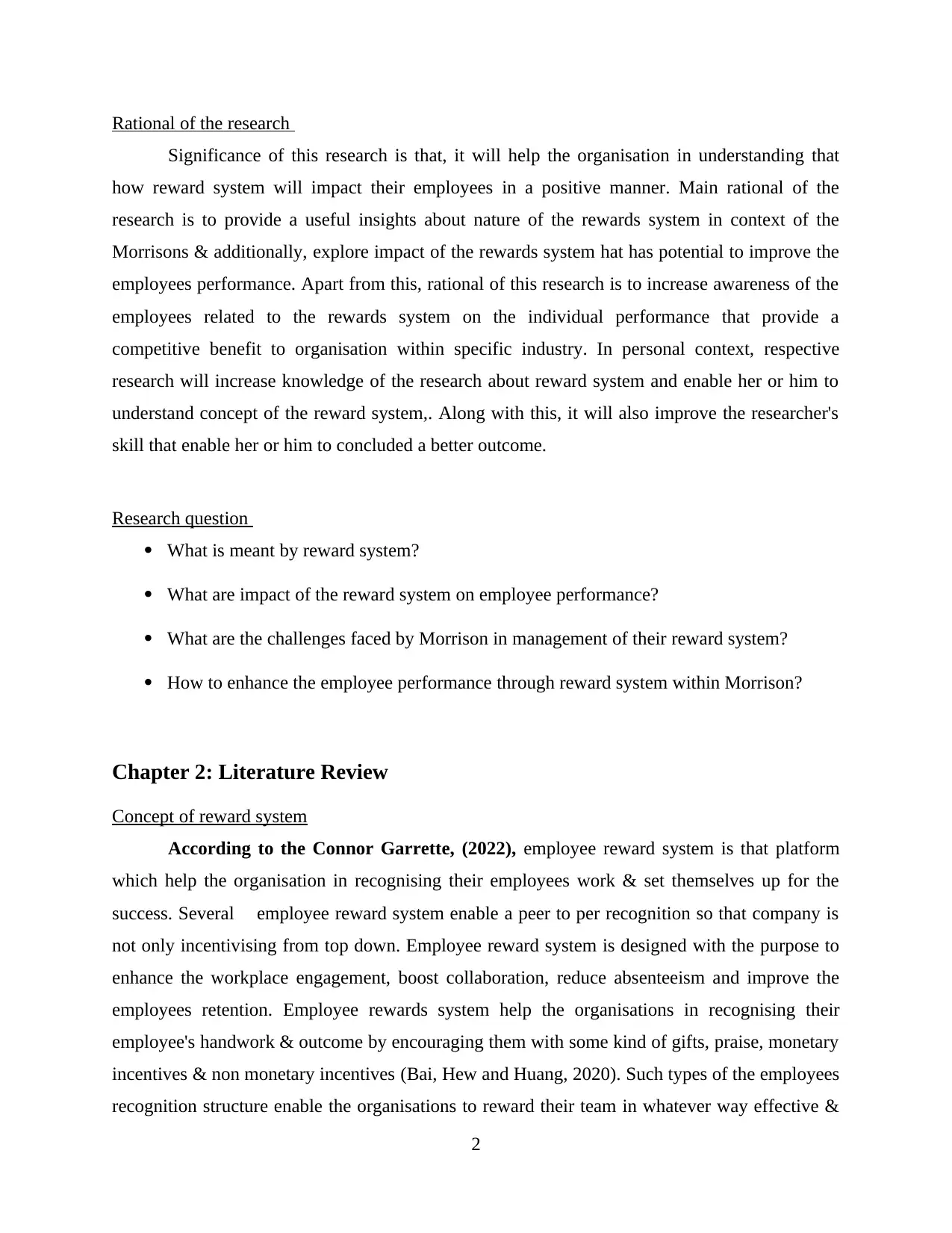
Rational of the research
Significance of this research is that, it will help the organisation in understanding that
how reward system will impact their employees in a positive manner. Main rational of the
research is to provide a useful insights about nature of the rewards system in context of the
Morrisons & additionally, explore impact of the rewards system hat has potential to improve the
employees performance. Apart from this, rational of this research is to increase awareness of the
employees related to the rewards system on the individual performance that provide a
competitive benefit to organisation within specific industry. In personal context, respective
research will increase knowledge of the research about reward system and enable her or him to
understand concept of the reward system,. Along with this, it will also improve the researcher's
skill that enable her or him to concluded a better outcome.
Research question
What is meant by reward system?
What are impact of the reward system on employee performance?
What are the challenges faced by Morrison in management of their reward system?
How to enhance the employee performance through reward system within Morrison?
Chapter 2: Literature Review
Concept of reward system
According to the Connor Garrette, (2022), employee reward system is that platform
which help the organisation in recognising their employees work & set themselves up for the
success. Several employee reward system enable a peer to per recognition so that company is
not only incentivising from top down. Employee reward system is designed with the purpose to
enhance the workplace engagement, boost collaboration, reduce absenteeism and improve the
employees retention. Employee rewards system help the organisations in recognising their
employee's handwork & outcome by encouraging them with some kind of gifts, praise, monetary
incentives & non monetary incentives (Bai, Hew and Huang, 2020). Such types of the employees
recognition structure enable the organisations to reward their team in whatever way effective &
2
Significance of this research is that, it will help the organisation in understanding that
how reward system will impact their employees in a positive manner. Main rational of the
research is to provide a useful insights about nature of the rewards system in context of the
Morrisons & additionally, explore impact of the rewards system hat has potential to improve the
employees performance. Apart from this, rational of this research is to increase awareness of the
employees related to the rewards system on the individual performance that provide a
competitive benefit to organisation within specific industry. In personal context, respective
research will increase knowledge of the research about reward system and enable her or him to
understand concept of the reward system,. Along with this, it will also improve the researcher's
skill that enable her or him to concluded a better outcome.
Research question
What is meant by reward system?
What are impact of the reward system on employee performance?
What are the challenges faced by Morrison in management of their reward system?
How to enhance the employee performance through reward system within Morrison?
Chapter 2: Literature Review
Concept of reward system
According to the Connor Garrette, (2022), employee reward system is that platform
which help the organisation in recognising their employees work & set themselves up for the
success. Several employee reward system enable a peer to per recognition so that company is
not only incentivising from top down. Employee reward system is designed with the purpose to
enhance the workplace engagement, boost collaboration, reduce absenteeism and improve the
employees retention. Employee rewards system help the organisations in recognising their
employee's handwork & outcome by encouraging them with some kind of gifts, praise, monetary
incentives & non monetary incentives (Bai, Hew and Huang, 2020). Such types of the employees
recognition structure enable the organisations to reward their team in whatever way effective &
2
Paraphrase This Document
Need a fresh take? Get an instant paraphrase of this document with our AI Paraphraser
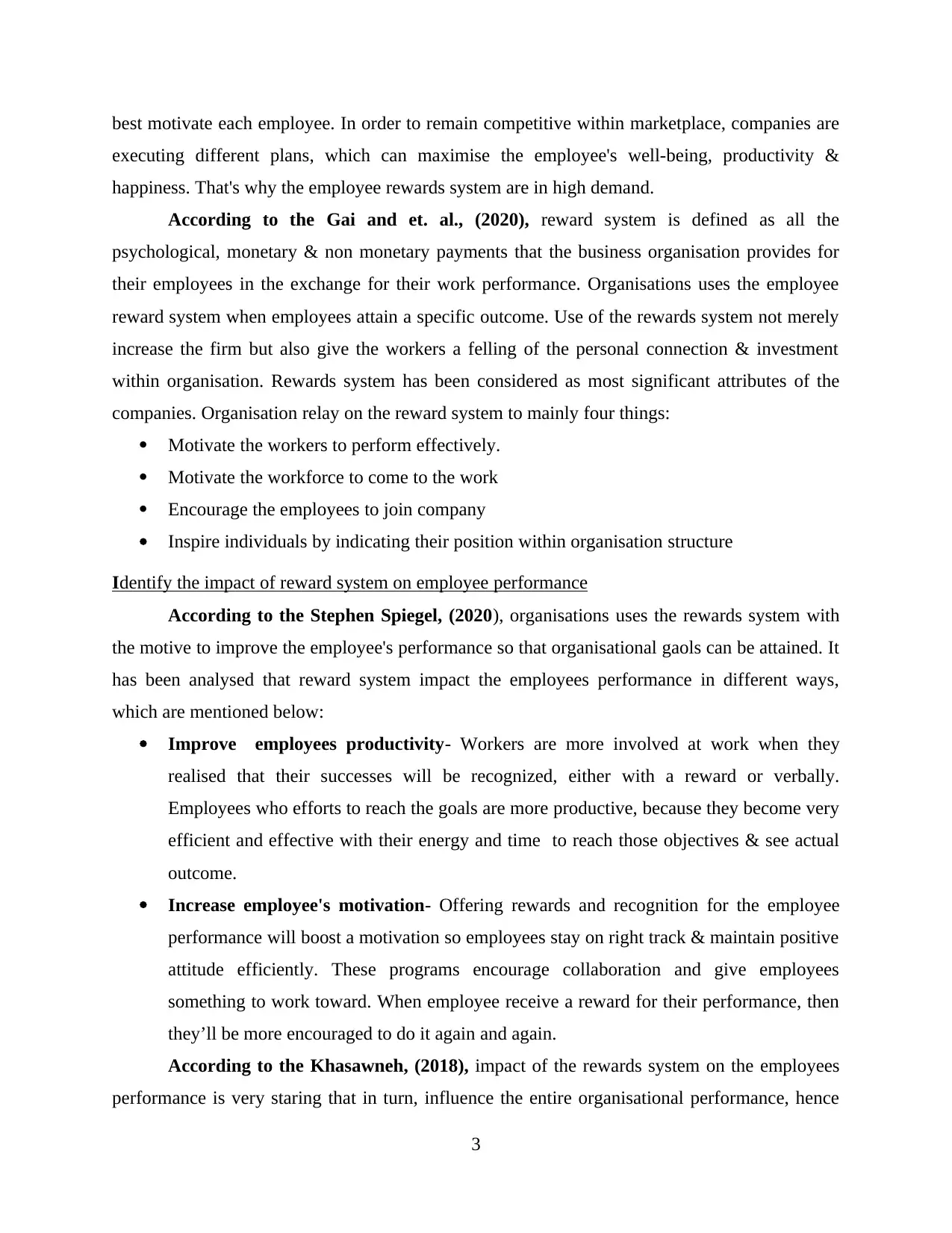
best motivate each employee. In order to remain competitive within marketplace, companies are
executing different plans, which can maximise the employee's well-being, productivity &
happiness. That's why the employee rewards system are in high demand.
According to the Gai and et. al., (2020), reward system is defined as all the
psychological, monetary & non monetary payments that the business organisation provides for
their employees in the exchange for their work performance. Organisations uses the employee
reward system when employees attain a specific outcome. Use of the rewards system not merely
increase the firm but also give the workers a felling of the personal connection & investment
within organisation. Rewards system has been considered as most significant attributes of the
companies. Organisation relay on the reward system to mainly four things:
Motivate the workers to perform effectively.
Motivate the workforce to come to the work
Encourage the employees to join company
Inspire individuals by indicating their position within organisation structure
Identify the impact of reward system on employee performance
According to the Stephen Spiegel, (2020), organisations uses the rewards system with
the motive to improve the employee's performance so that organisational gaols can be attained. It
has been analysed that reward system impact the employees performance in different ways,
which are mentioned below:
Improve employees productivity- Workers are more involved at work when they
realised that their successes will be recognized, either with a reward or verbally.
Employees who efforts to reach the goals are more productive, because they become very
efficient and effective with their energy and time to reach those objectives & see actual
outcome.
Increase employee's motivation- Offering rewards and recognition for the employee
performance will boost a motivation so employees stay on right track & maintain positive
attitude efficiently. These programs encourage collaboration and give employees
something to work toward. When employee receive a reward for their performance, then
they’ll be more encouraged to do it again and again.
According to the Khasawneh, (2018), impact of the rewards system on the employees
performance is very staring that in turn, influence the entire organisational performance, hence
3
executing different plans, which can maximise the employee's well-being, productivity &
happiness. That's why the employee rewards system are in high demand.
According to the Gai and et. al., (2020), reward system is defined as all the
psychological, monetary & non monetary payments that the business organisation provides for
their employees in the exchange for their work performance. Organisations uses the employee
reward system when employees attain a specific outcome. Use of the rewards system not merely
increase the firm but also give the workers a felling of the personal connection & investment
within organisation. Rewards system has been considered as most significant attributes of the
companies. Organisation relay on the reward system to mainly four things:
Motivate the workers to perform effectively.
Motivate the workforce to come to the work
Encourage the employees to join company
Inspire individuals by indicating their position within organisation structure
Identify the impact of reward system on employee performance
According to the Stephen Spiegel, (2020), organisations uses the rewards system with
the motive to improve the employee's performance so that organisational gaols can be attained. It
has been analysed that reward system impact the employees performance in different ways,
which are mentioned below:
Improve employees productivity- Workers are more involved at work when they
realised that their successes will be recognized, either with a reward or verbally.
Employees who efforts to reach the goals are more productive, because they become very
efficient and effective with their energy and time to reach those objectives & see actual
outcome.
Increase employee's motivation- Offering rewards and recognition for the employee
performance will boost a motivation so employees stay on right track & maintain positive
attitude efficiently. These programs encourage collaboration and give employees
something to work toward. When employee receive a reward for their performance, then
they’ll be more encouraged to do it again and again.
According to the Khasawneh, (2018), impact of the rewards system on the employees
performance is very staring that in turn, influence the entire organisational performance, hence
3
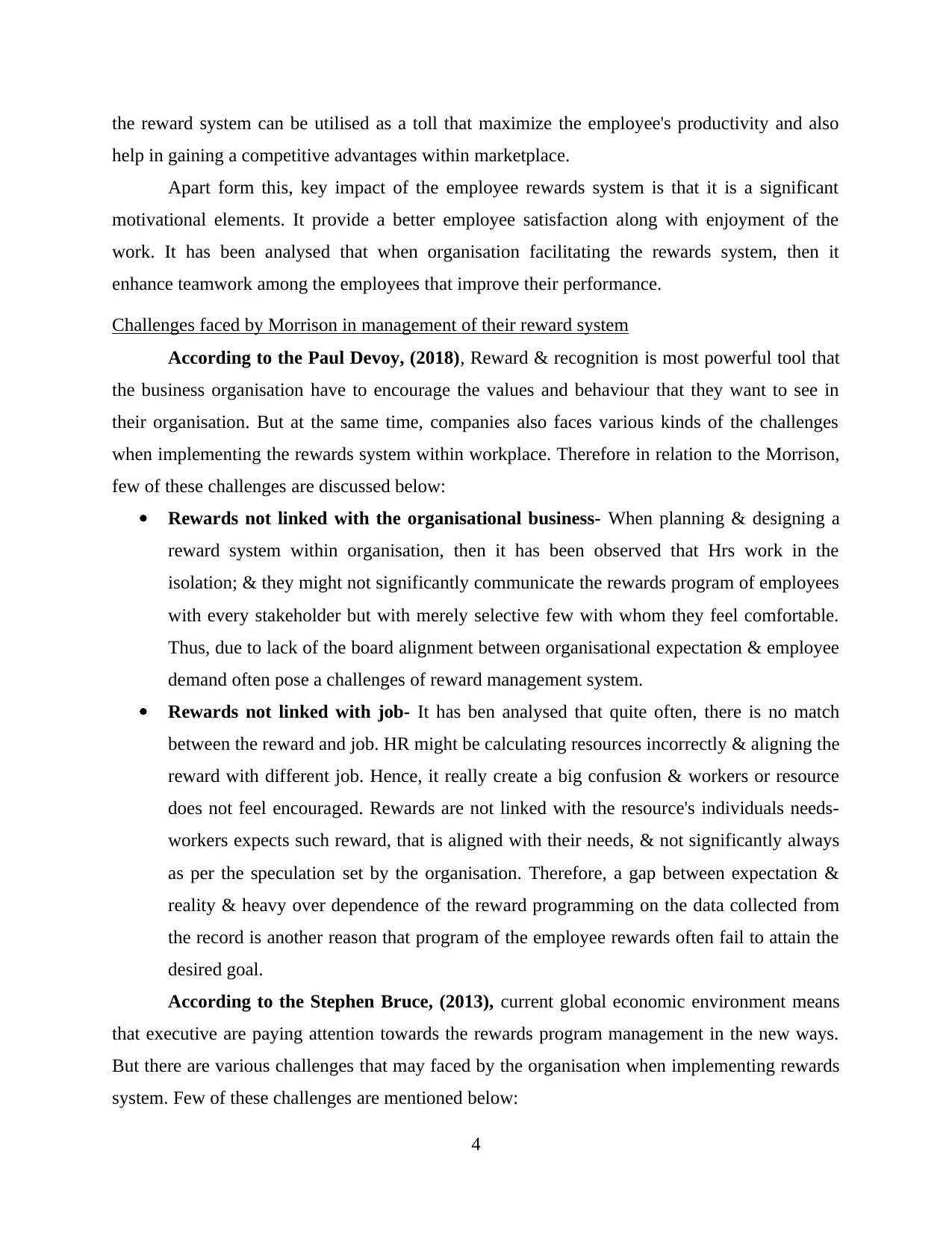
the reward system can be utilised as a toll that maximize the employee's productivity and also
help in gaining a competitive advantages within marketplace.
Apart form this, key impact of the employee rewards system is that it is a significant
motivational elements. It provide a better employee satisfaction along with enjoyment of the
work. It has been analysed that when organisation facilitating the rewards system, then it
enhance teamwork among the employees that improve their performance.
Challenges faced by Morrison in management of their reward system
According to the Paul Devoy, (2018), Reward & recognition is most powerful tool that
the business organisation have to encourage the values and behaviour that they want to see in
their organisation. But at the same time, companies also faces various kinds of the challenges
when implementing the rewards system within workplace. Therefore in relation to the Morrison,
few of these challenges are discussed below:
Rewards not linked with the organisational business- When planning & designing a
reward system within organisation, then it has been observed that Hrs work in the
isolation; & they might not significantly communicate the rewards program of employees
with every stakeholder but with merely selective few with whom they feel comfortable.
Thus, due to lack of the board alignment between organisational expectation & employee
demand often pose a challenges of reward management system.
Rewards not linked with job- It has ben analysed that quite often, there is no match
between the reward and job. HR might be calculating resources incorrectly & aligning the
reward with different job. Hence, it really create a big confusion & workers or resource
does not feel encouraged. Rewards are not linked with the resource's individuals needs-
workers expects such reward, that is aligned with their needs, & not significantly always
as per the speculation set by the organisation. Therefore, a gap between expectation &
reality & heavy over dependence of the reward programming on the data collected from
the record is another reason that program of the employee rewards often fail to attain the
desired goal.
According to the Stephen Bruce, (2013), current global economic environment means
that executive are paying attention towards the rewards program management in the new ways.
But there are various challenges that may faced by the organisation when implementing rewards
system. Few of these challenges are mentioned below:
4
help in gaining a competitive advantages within marketplace.
Apart form this, key impact of the employee rewards system is that it is a significant
motivational elements. It provide a better employee satisfaction along with enjoyment of the
work. It has been analysed that when organisation facilitating the rewards system, then it
enhance teamwork among the employees that improve their performance.
Challenges faced by Morrison in management of their reward system
According to the Paul Devoy, (2018), Reward & recognition is most powerful tool that
the business organisation have to encourage the values and behaviour that they want to see in
their organisation. But at the same time, companies also faces various kinds of the challenges
when implementing the rewards system within workplace. Therefore in relation to the Morrison,
few of these challenges are discussed below:
Rewards not linked with the organisational business- When planning & designing a
reward system within organisation, then it has been observed that Hrs work in the
isolation; & they might not significantly communicate the rewards program of employees
with every stakeholder but with merely selective few with whom they feel comfortable.
Thus, due to lack of the board alignment between organisational expectation & employee
demand often pose a challenges of reward management system.
Rewards not linked with job- It has ben analysed that quite often, there is no match
between the reward and job. HR might be calculating resources incorrectly & aligning the
reward with different job. Hence, it really create a big confusion & workers or resource
does not feel encouraged. Rewards are not linked with the resource's individuals needs-
workers expects such reward, that is aligned with their needs, & not significantly always
as per the speculation set by the organisation. Therefore, a gap between expectation &
reality & heavy over dependence of the reward programming on the data collected from
the record is another reason that program of the employee rewards often fail to attain the
desired goal.
According to the Stephen Bruce, (2013), current global economic environment means
that executive are paying attention towards the rewards program management in the new ways.
But there are various challenges that may faced by the organisation when implementing rewards
system. Few of these challenges are mentioned below:
4
⊘ This is a preview!⊘
Do you want full access?
Subscribe today to unlock all pages.

Trusted by 1+ million students worldwide
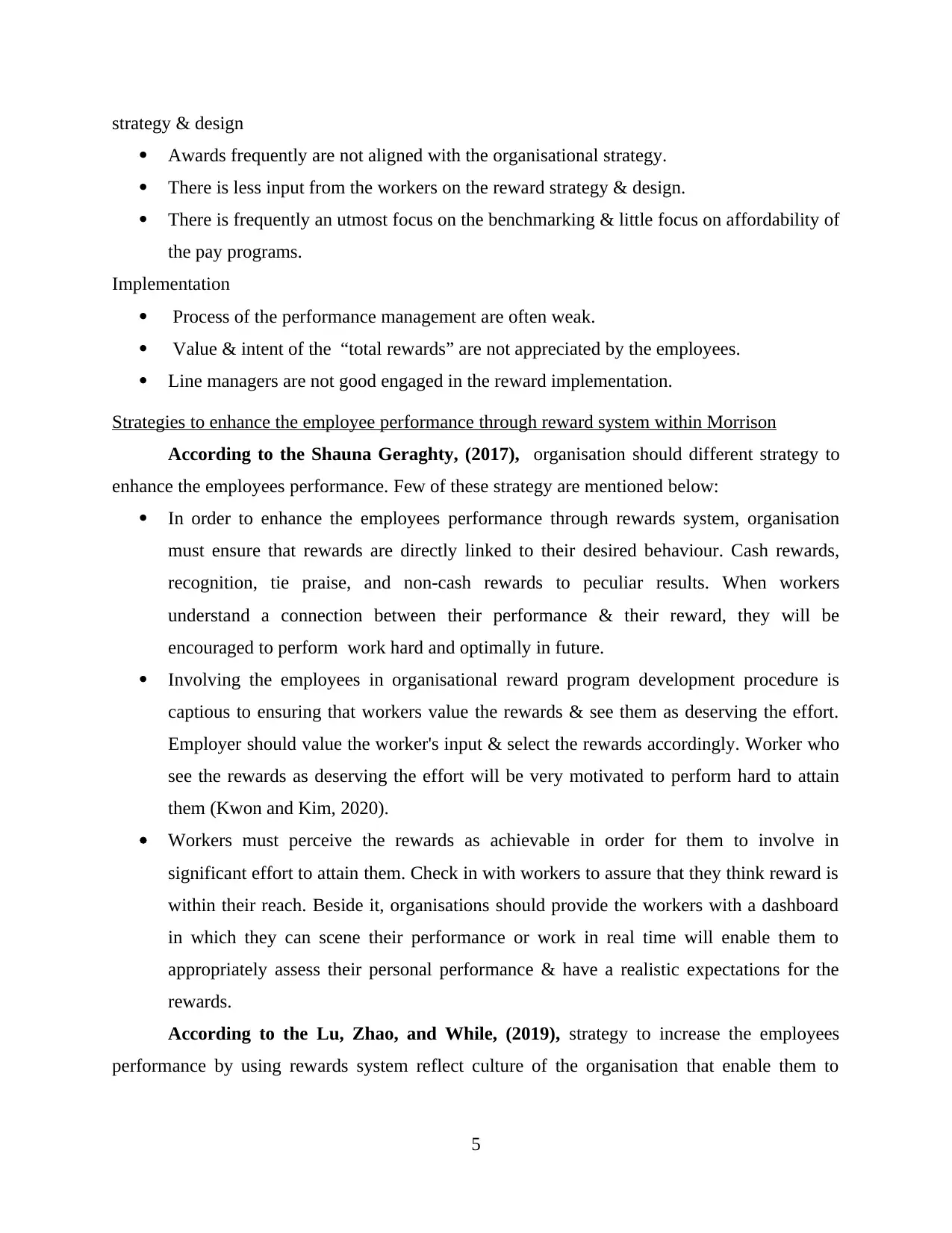
strategy & design
Awards frequently are not aligned with the organisational strategy.
There is less input from the workers on the reward strategy & design.
There is frequently an utmost focus on the benchmarking & little focus on affordability of
the pay programs.
Implementation
Process of the performance management are often weak.
Value & intent of the “total rewards” are not appreciated by the employees.
Line managers are not good engaged in the reward implementation.
Strategies to enhance the employee performance through reward system within Morrison
According to the Shauna Geraghty, (2017), organisation should different strategy to
enhance the employees performance. Few of these strategy are mentioned below:
In order to enhance the employees performance through rewards system, organisation
must ensure that rewards are directly linked to their desired behaviour. Cash rewards,
recognition, tie praise, and non-cash rewards to peculiar results. When workers
understand a connection between their performance & their reward, they will be
encouraged to perform work hard and optimally in future.
Involving the employees in organisational reward program development procedure is
captious to ensuring that workers value the rewards & see them as deserving the effort.
Employer should value the worker's input & select the rewards accordingly. Worker who
see the rewards as deserving the effort will be very motivated to perform hard to attain
them (Kwon and Kim, 2020).
Workers must perceive the rewards as achievable in order for them to involve in
significant effort to attain them. Check in with workers to assure that they think reward is
within their reach. Beside it, organisations should provide the workers with a dashboard
in which they can scene their performance or work in real time will enable them to
appropriately assess their personal performance & have a realistic expectations for the
rewards.
According to the Lu, Zhao, and While, (2019), strategy to increase the employees
performance by using rewards system reflect culture of the organisation that enable them to
5
Awards frequently are not aligned with the organisational strategy.
There is less input from the workers on the reward strategy & design.
There is frequently an utmost focus on the benchmarking & little focus on affordability of
the pay programs.
Implementation
Process of the performance management are often weak.
Value & intent of the “total rewards” are not appreciated by the employees.
Line managers are not good engaged in the reward implementation.
Strategies to enhance the employee performance through reward system within Morrison
According to the Shauna Geraghty, (2017), organisation should different strategy to
enhance the employees performance. Few of these strategy are mentioned below:
In order to enhance the employees performance through rewards system, organisation
must ensure that rewards are directly linked to their desired behaviour. Cash rewards,
recognition, tie praise, and non-cash rewards to peculiar results. When workers
understand a connection between their performance & their reward, they will be
encouraged to perform work hard and optimally in future.
Involving the employees in organisational reward program development procedure is
captious to ensuring that workers value the rewards & see them as deserving the effort.
Employer should value the worker's input & select the rewards accordingly. Worker who
see the rewards as deserving the effort will be very motivated to perform hard to attain
them (Kwon and Kim, 2020).
Workers must perceive the rewards as achievable in order for them to involve in
significant effort to attain them. Check in with workers to assure that they think reward is
within their reach. Beside it, organisations should provide the workers with a dashboard
in which they can scene their performance or work in real time will enable them to
appropriately assess their personal performance & have a realistic expectations for the
rewards.
According to the Lu, Zhao, and While, (2019), strategy to increase the employees
performance by using rewards system reflect culture of the organisation that enable them to
5
Paraphrase This Document
Need a fresh take? Get an instant paraphrase of this document with our AI Paraphraser
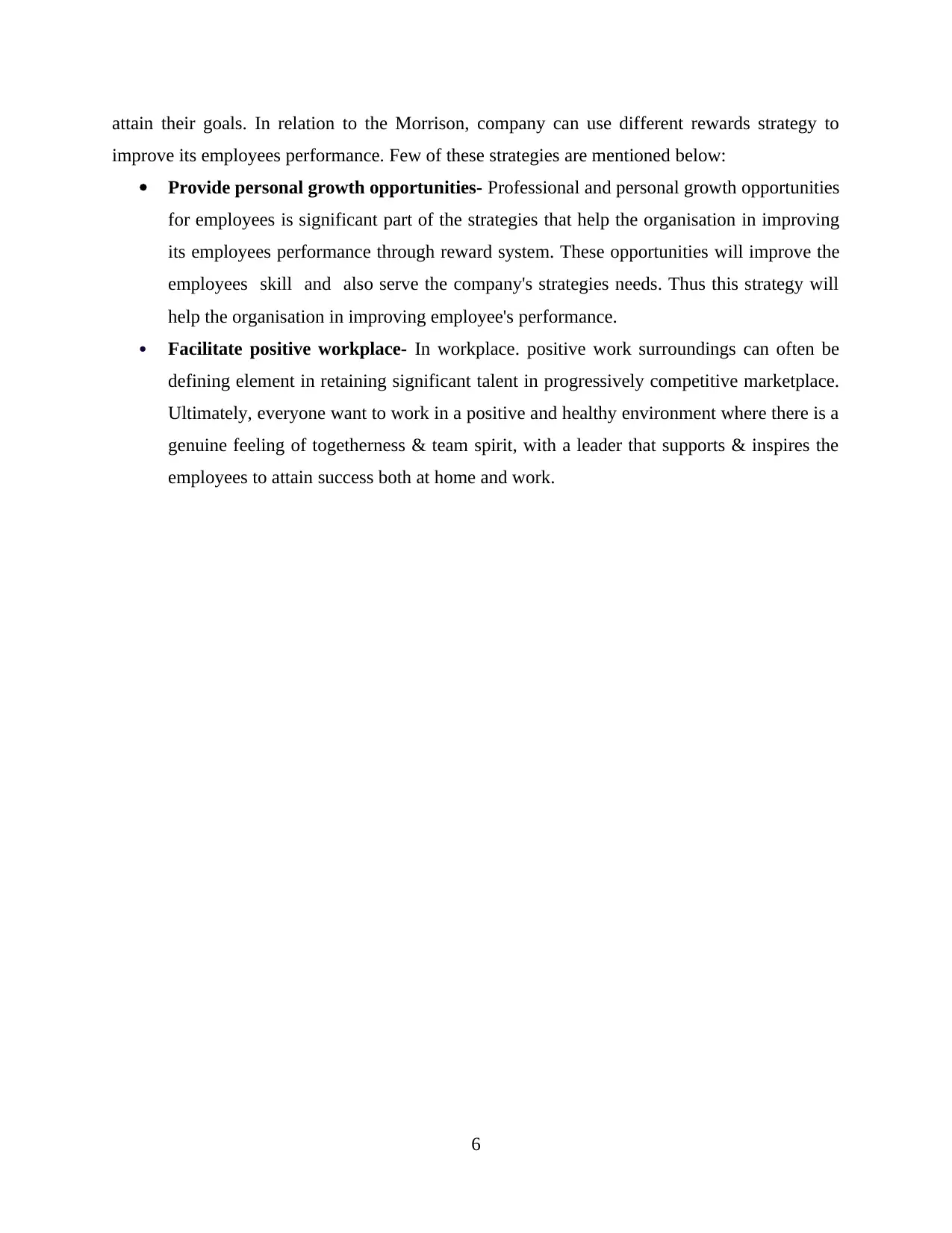
attain their goals. In relation to the Morrison, company can use different rewards strategy to
improve its employees performance. Few of these strategies are mentioned below:
Provide personal growth opportunities- Professional and personal growth opportunities
for employees is significant part of the strategies that help the organisation in improving
its employees performance through reward system. These opportunities will improve the
employees skill and also serve the company's strategies needs. Thus this strategy will
help the organisation in improving employee's performance.
Facilitate positive workplace- In workplace. positive work surroundings can often be
defining element in retaining significant talent in progressively competitive marketplace.
Ultimately, everyone want to work in a positive and healthy environment where there is a
genuine feeling of togetherness & team spirit, with a leader that supports & inspires the
employees to attain success both at home and work.
6
improve its employees performance. Few of these strategies are mentioned below:
Provide personal growth opportunities- Professional and personal growth opportunities
for employees is significant part of the strategies that help the organisation in improving
its employees performance through reward system. These opportunities will improve the
employees skill and also serve the company's strategies needs. Thus this strategy will
help the organisation in improving employee's performance.
Facilitate positive workplace- In workplace. positive work surroundings can often be
defining element in retaining significant talent in progressively competitive marketplace.
Ultimately, everyone want to work in a positive and healthy environment where there is a
genuine feeling of togetherness & team spirit, with a leader that supports & inspires the
employees to attain success both at home and work.
6
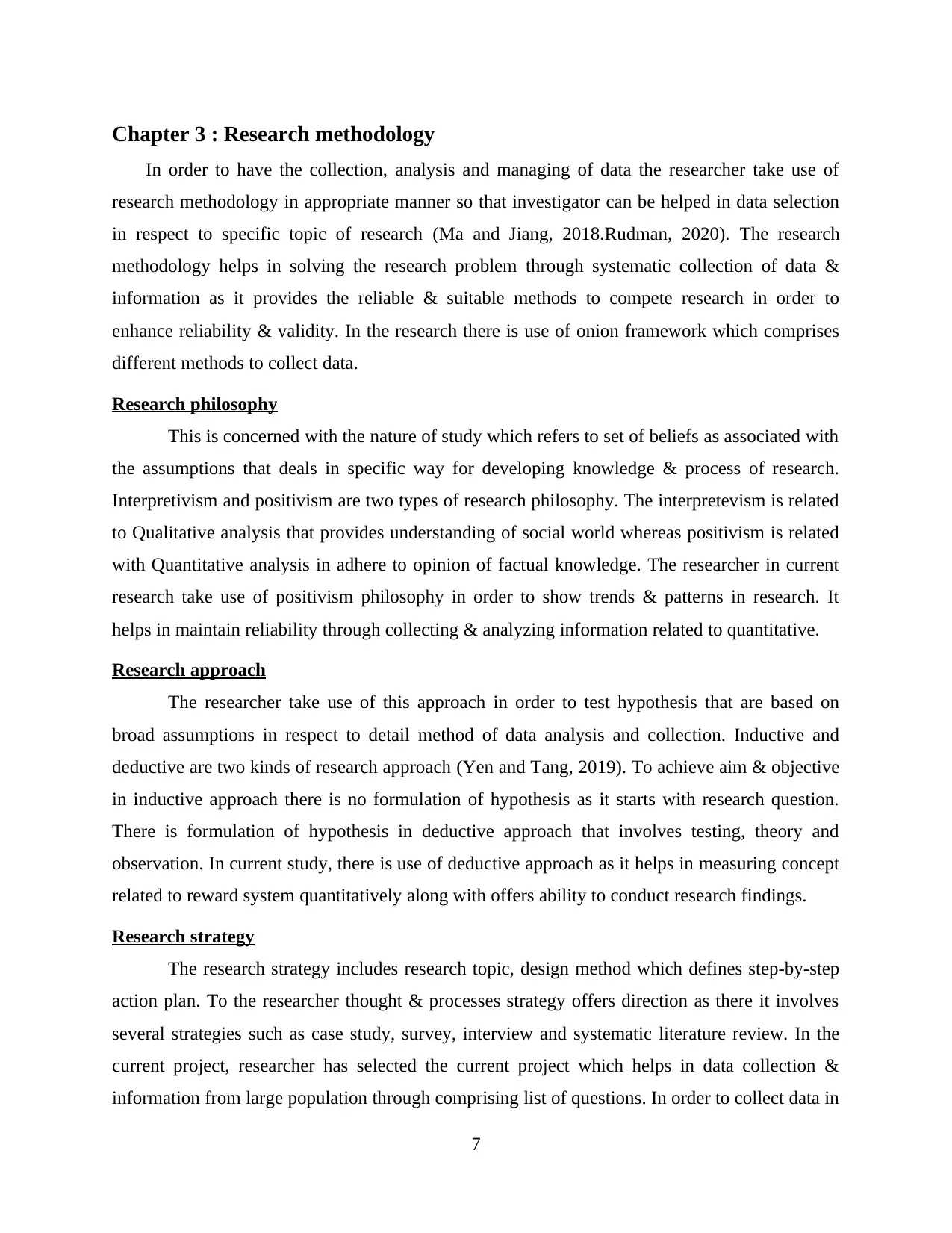
Chapter 3 : Research methodology
In order to have the collection, analysis and managing of data the researcher take use of
research methodology in appropriate manner so that investigator can be helped in data selection
in respect to specific topic of research (Ma and Jiang, 2018.Rudman, 2020). The research
methodology helps in solving the research problem through systematic collection of data &
information as it provides the reliable & suitable methods to compete research in order to
enhance reliability & validity. In the research there is use of onion framework which comprises
different methods to collect data.
Research philosophy
This is concerned with the nature of study which refers to set of beliefs as associated with
the assumptions that deals in specific way for developing knowledge & process of research.
Interpretivism and positivism are two types of research philosophy. The interpretevism is related
to Qualitative analysis that provides understanding of social world whereas positivism is related
with Quantitative analysis in adhere to opinion of factual knowledge. The researcher in current
research take use of positivism philosophy in order to show trends & patterns in research. It
helps in maintain reliability through collecting & analyzing information related to quantitative.
Research approach
The researcher take use of this approach in order to test hypothesis that are based on
broad assumptions in respect to detail method of data analysis and collection. Inductive and
deductive are two kinds of research approach (Yen and Tang, 2019). To achieve aim & objective
in inductive approach there is no formulation of hypothesis as it starts with research question.
There is formulation of hypothesis in deductive approach that involves testing, theory and
observation. In current study, there is use of deductive approach as it helps in measuring concept
related to reward system quantitatively along with offers ability to conduct research findings.
Research strategy
The research strategy includes research topic, design method which defines step-by-step
action plan. To the researcher thought & processes strategy offers direction as there it involves
several strategies such as case study, survey, interview and systematic literature review. In the
current project, researcher has selected the current project which helps in data collection &
information from large population through comprising list of questions. In order to collect data in
7
In order to have the collection, analysis and managing of data the researcher take use of
research methodology in appropriate manner so that investigator can be helped in data selection
in respect to specific topic of research (Ma and Jiang, 2018.Rudman, 2020). The research
methodology helps in solving the research problem through systematic collection of data &
information as it provides the reliable & suitable methods to compete research in order to
enhance reliability & validity. In the research there is use of onion framework which comprises
different methods to collect data.
Research philosophy
This is concerned with the nature of study which refers to set of beliefs as associated with
the assumptions that deals in specific way for developing knowledge & process of research.
Interpretivism and positivism are two types of research philosophy. The interpretevism is related
to Qualitative analysis that provides understanding of social world whereas positivism is related
with Quantitative analysis in adhere to opinion of factual knowledge. The researcher in current
research take use of positivism philosophy in order to show trends & patterns in research. It
helps in maintain reliability through collecting & analyzing information related to quantitative.
Research approach
The researcher take use of this approach in order to test hypothesis that are based on
broad assumptions in respect to detail method of data analysis and collection. Inductive and
deductive are two kinds of research approach (Yen and Tang, 2019). To achieve aim & objective
in inductive approach there is no formulation of hypothesis as it starts with research question.
There is formulation of hypothesis in deductive approach that involves testing, theory and
observation. In current study, there is use of deductive approach as it helps in measuring concept
related to reward system quantitatively along with offers ability to conduct research findings.
Research strategy
The research strategy includes research topic, design method which defines step-by-step
action plan. To the researcher thought & processes strategy offers direction as there it involves
several strategies such as case study, survey, interview and systematic literature review. In the
current project, researcher has selected the current project which helps in data collection &
information from large population through comprising list of questions. In order to collect data in
7
⊘ This is a preview!⊘
Do you want full access?
Subscribe today to unlock all pages.

Trusted by 1+ million students worldwide
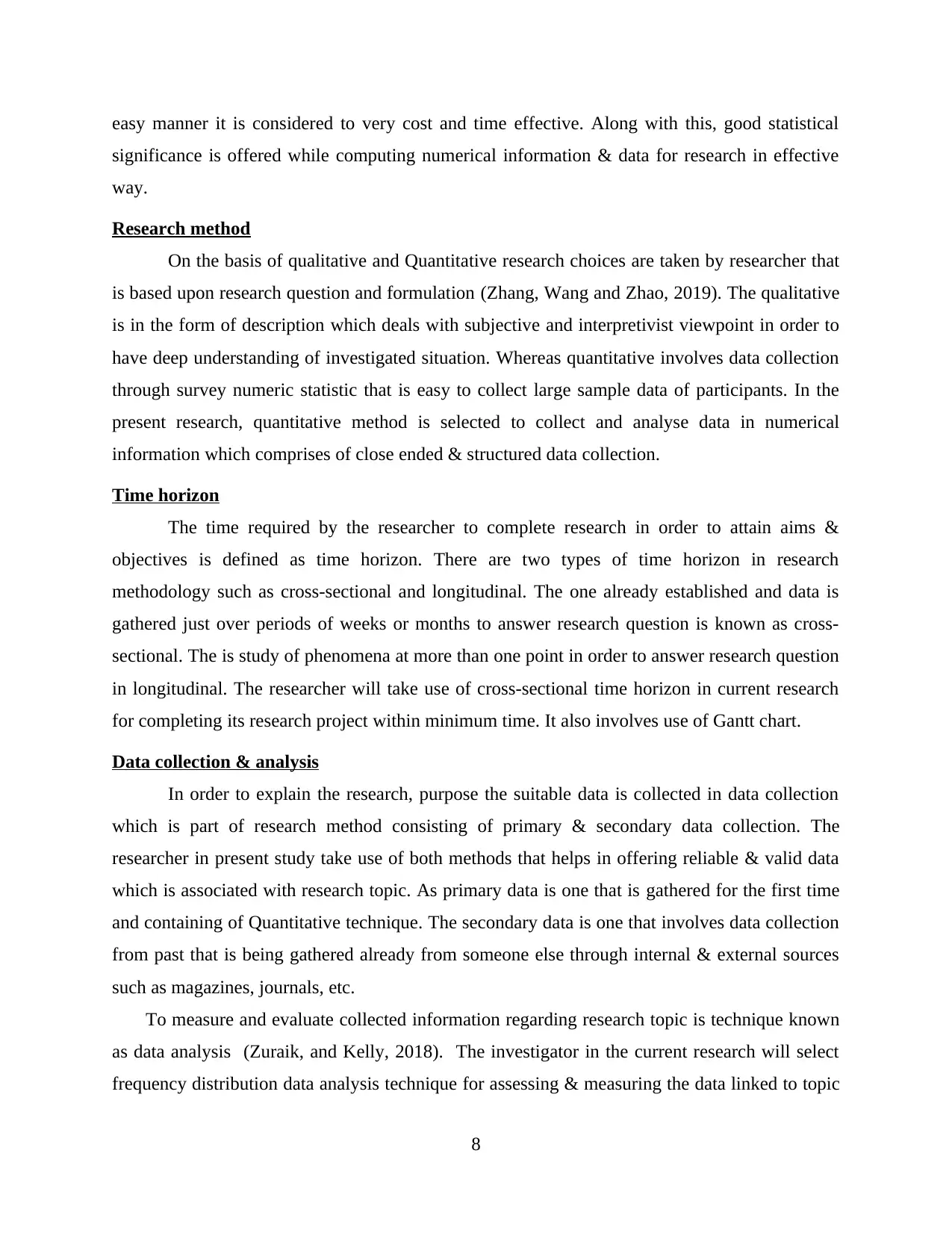
easy manner it is considered to very cost and time effective. Along with this, good statistical
significance is offered while computing numerical information & data for research in effective
way.
Research method
On the basis of qualitative and Quantitative research choices are taken by researcher that
is based upon research question and formulation (Zhang, Wang and Zhao, 2019). The qualitative
is in the form of description which deals with subjective and interpretivist viewpoint in order to
have deep understanding of investigated situation. Whereas quantitative involves data collection
through survey numeric statistic that is easy to collect large sample data of participants. In the
present research, quantitative method is selected to collect and analyse data in numerical
information which comprises of close ended & structured data collection.
Time horizon
The time required by the researcher to complete research in order to attain aims &
objectives is defined as time horizon. There are two types of time horizon in research
methodology such as cross-sectional and longitudinal. The one already established and data is
gathered just over periods of weeks or months to answer research question is known as cross-
sectional. The is study of phenomena at more than one point in order to answer research question
in longitudinal. The researcher will take use of cross-sectional time horizon in current research
for completing its research project within minimum time. It also involves use of Gantt chart.
Data collection & analysis
In order to explain the research, purpose the suitable data is collected in data collection
which is part of research method consisting of primary & secondary data collection. The
researcher in present study take use of both methods that helps in offering reliable & valid data
which is associated with research topic. As primary data is one that is gathered for the first time
and containing of Quantitative technique. The secondary data is one that involves data collection
from past that is being gathered already from someone else through internal & external sources
such as magazines, journals, etc.
To measure and evaluate collected information regarding research topic is technique known
as data analysis (Zuraik, and Kelly, 2018). The investigator in the current research will select
frequency distribution data analysis technique for assessing & measuring the data linked to topic
8
significance is offered while computing numerical information & data for research in effective
way.
Research method
On the basis of qualitative and Quantitative research choices are taken by researcher that
is based upon research question and formulation (Zhang, Wang and Zhao, 2019). The qualitative
is in the form of description which deals with subjective and interpretivist viewpoint in order to
have deep understanding of investigated situation. Whereas quantitative involves data collection
through survey numeric statistic that is easy to collect large sample data of participants. In the
present research, quantitative method is selected to collect and analyse data in numerical
information which comprises of close ended & structured data collection.
Time horizon
The time required by the researcher to complete research in order to attain aims &
objectives is defined as time horizon. There are two types of time horizon in research
methodology such as cross-sectional and longitudinal. The one already established and data is
gathered just over periods of weeks or months to answer research question is known as cross-
sectional. The is study of phenomena at more than one point in order to answer research question
in longitudinal. The researcher will take use of cross-sectional time horizon in current research
for completing its research project within minimum time. It also involves use of Gantt chart.
Data collection & analysis
In order to explain the research, purpose the suitable data is collected in data collection
which is part of research method consisting of primary & secondary data collection. The
researcher in present study take use of both methods that helps in offering reliable & valid data
which is associated with research topic. As primary data is one that is gathered for the first time
and containing of Quantitative technique. The secondary data is one that involves data collection
from past that is being gathered already from someone else through internal & external sources
such as magazines, journals, etc.
To measure and evaluate collected information regarding research topic is technique known
as data analysis (Zuraik, and Kelly, 2018). The investigator in the current research will select
frequency distribution data analysis technique for assessing & measuring the data linked to topic
8
Paraphrase This Document
Need a fresh take? Get an instant paraphrase of this document with our AI Paraphraser
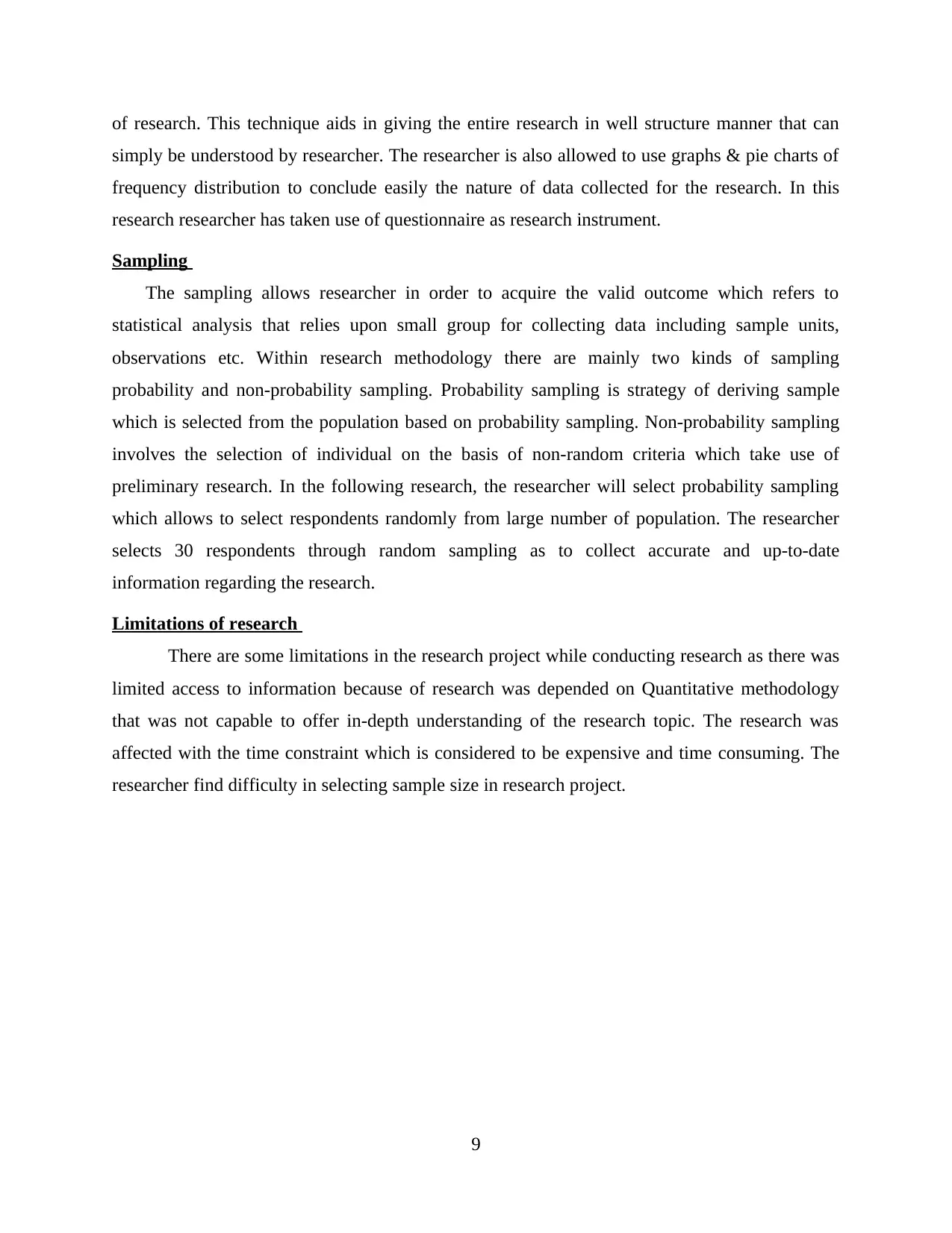
of research. This technique aids in giving the entire research in well structure manner that can
simply be understood by researcher. The researcher is also allowed to use graphs & pie charts of
frequency distribution to conclude easily the nature of data collected for the research. In this
research researcher has taken use of questionnaire as research instrument.
Sampling
The sampling allows researcher in order to acquire the valid outcome which refers to
statistical analysis that relies upon small group for collecting data including sample units,
observations etc. Within research methodology there are mainly two kinds of sampling
probability and non-probability sampling. Probability sampling is strategy of deriving sample
which is selected from the population based on probability sampling. Non-probability sampling
involves the selection of individual on the basis of non-random criteria which take use of
preliminary research. In the following research, the researcher will select probability sampling
which allows to select respondents randomly from large number of population. The researcher
selects 30 respondents through random sampling as to collect accurate and up-to-date
information regarding the research.
Limitations of research
There are some limitations in the research project while conducting research as there was
limited access to information because of research was depended on Quantitative methodology
that was not capable to offer in-depth understanding of the research topic. The research was
affected with the time constraint which is considered to be expensive and time consuming. The
researcher find difficulty in selecting sample size in research project.
9
simply be understood by researcher. The researcher is also allowed to use graphs & pie charts of
frequency distribution to conclude easily the nature of data collected for the research. In this
research researcher has taken use of questionnaire as research instrument.
Sampling
The sampling allows researcher in order to acquire the valid outcome which refers to
statistical analysis that relies upon small group for collecting data including sample units,
observations etc. Within research methodology there are mainly two kinds of sampling
probability and non-probability sampling. Probability sampling is strategy of deriving sample
which is selected from the population based on probability sampling. Non-probability sampling
involves the selection of individual on the basis of non-random criteria which take use of
preliminary research. In the following research, the researcher will select probability sampling
which allows to select respondents randomly from large number of population. The researcher
selects 30 respondents through random sampling as to collect accurate and up-to-date
information regarding the research.
Limitations of research
There are some limitations in the research project while conducting research as there was
limited access to information because of research was depended on Quantitative methodology
that was not capable to offer in-depth understanding of the research topic. The research was
affected with the time constraint which is considered to be expensive and time consuming. The
researcher find difficulty in selecting sample size in research project.
9
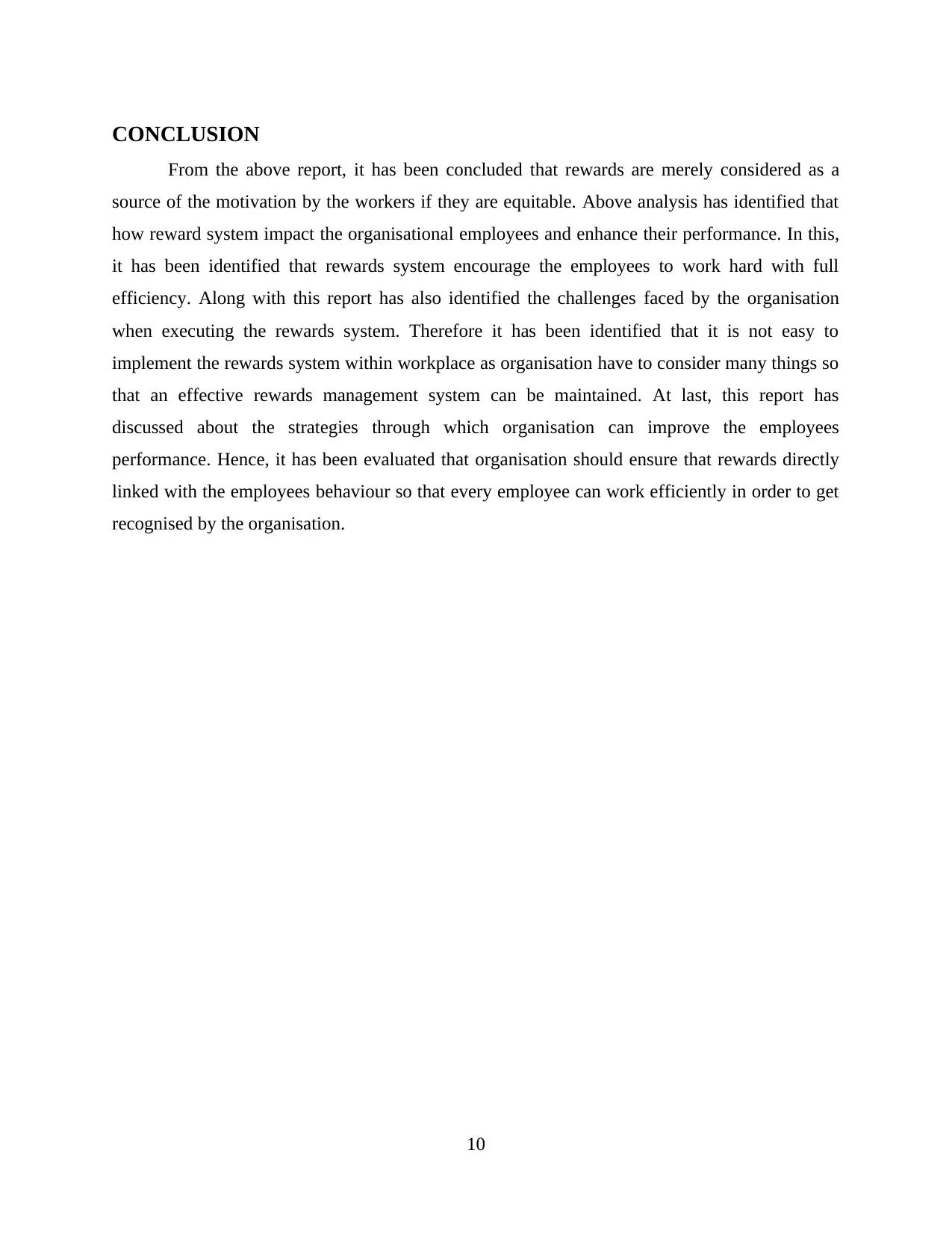
CONCLUSION
From the above report, it has been concluded that rewards are merely considered as a
source of the motivation by the workers if they are equitable. Above analysis has identified that
how reward system impact the organisational employees and enhance their performance. In this,
it has been identified that rewards system encourage the employees to work hard with full
efficiency. Along with this report has also identified the challenges faced by the organisation
when executing the rewards system. Therefore it has been identified that it is not easy to
implement the rewards system within workplace as organisation have to consider many things so
that an effective rewards management system can be maintained. At last, this report has
discussed about the strategies through which organisation can improve the employees
performance. Hence, it has been evaluated that organisation should ensure that rewards directly
linked with the employees behaviour so that every employee can work efficiently in order to get
recognised by the organisation.
10
From the above report, it has been concluded that rewards are merely considered as a
source of the motivation by the workers if they are equitable. Above analysis has identified that
how reward system impact the organisational employees and enhance their performance. In this,
it has been identified that rewards system encourage the employees to work hard with full
efficiency. Along with this report has also identified the challenges faced by the organisation
when executing the rewards system. Therefore it has been identified that it is not easy to
implement the rewards system within workplace as organisation have to consider many things so
that an effective rewards management system can be maintained. At last, this report has
discussed about the strategies through which organisation can improve the employees
performance. Hence, it has been evaluated that organisation should ensure that rewards directly
linked with the employees behaviour so that every employee can work efficiently in order to get
recognised by the organisation.
10
⊘ This is a preview!⊘
Do you want full access?
Subscribe today to unlock all pages.

Trusted by 1+ million students worldwide
1 out of 14
Related Documents
Your All-in-One AI-Powered Toolkit for Academic Success.
+13062052269
info@desklib.com
Available 24*7 on WhatsApp / Email
![[object Object]](/_next/static/media/star-bottom.7253800d.svg)
Unlock your academic potential
Copyright © 2020–2025 A2Z Services. All Rights Reserved. Developed and managed by ZUCOL.





